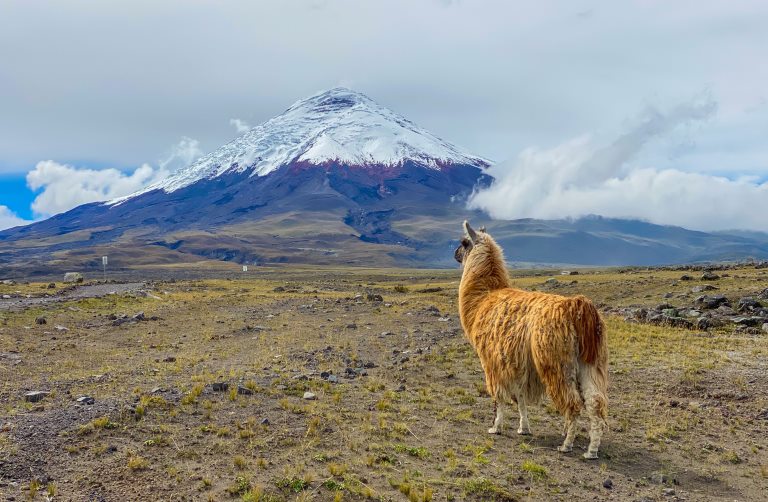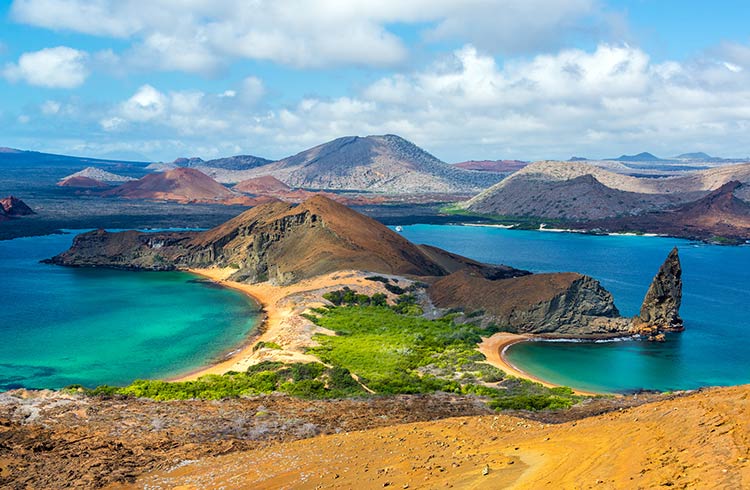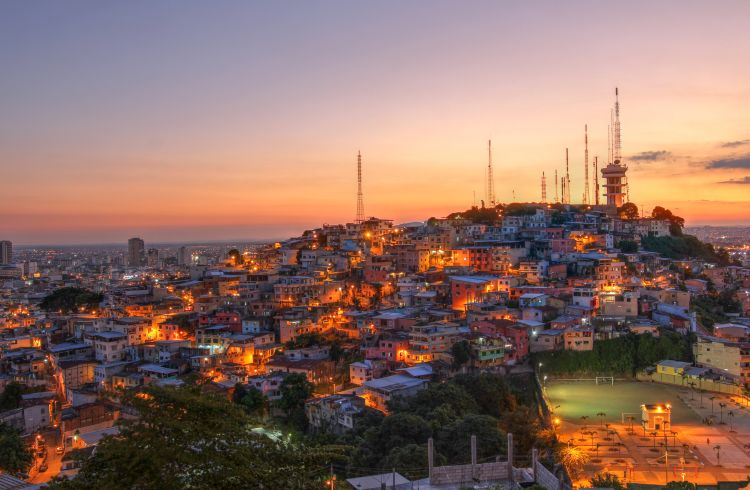Adventure Sports in Ecuador: Essential Travel Safety Tips
A popular destination for adventure travelers, Ecuador is a one-stop shop for all things thrillseeking and exciting. We show you how to have a good time safely.
 Photo © iStock.com/PatricioHidalgoP
Photo © iStock.com/PatricioHidalgoP
With such diverse geography and climate, it's not a stretch of the imagination to climb up snowy mountains and erupting volcanoes one day, then abseil down beautiful beach cliffs the next.
There is a lot to do, so let's take a look at some of the most thrilling adventure activities. What gets your adrenaline pumping? What are the riskier adventures? And what should be left only to those who have completely lost their minds?
- Volcano Hiking Treks
- Amazon Rainforest Tours in Ecuador
- White Water Rafting
- Puenting: Ecuadorian Bridge Jumping
- Mountain Biking Adventures
Volcano hiking treks
We'll start with an activity for those who like a fitness challenge – trekking up one of Ecuador's 45 volcanoes.
Not all of Ecuador's volcanoes are currently active or dangerous.
Despite the warnings, and you know, the huge plumes of molten lava erupting from them, hundreds of travelers still take to mother nature's monumental earth bazookas to literally play with fire.
Having said that, most of Ecuador's volcanoes haven't erupted for some time and are relatively safe for a fun climb – but there are still risks.
If you are planning a climb there is only one real thing you should consider aside from obvious safety precautions – if the difficulty of the hike requires you to need ropes, your insurance won't cover you if you take a fall.
Cotopaxi is one of the popular volcanoes in Ecuador. It erupted in August 2015 and was recently reopened in October 2017. You can now hike up to the shelter and to the summit with a guide.
The most important thing is that you need a guide to hike any summit basically and it is recommended to acclimatize and exercise beforehand. Most climbers don’t make it to the summit because of altitude sickness. Altitude sickness pills are easy to get at the pharmacies.
Amazon rainforest tours in Ecuador
The upper Amazon basin is situated to the east of the Andes in Ecuador and it's a relatively travel-friendly area.
There is a huge display of flora and fauna. Among Ecuador's thousands of orchid species and medicinal plants, you'll find butterflies, monkeys, sloths, macaws, river dolphins and bats.
Aside from feeling like you have stepped into a David Attenborough nature documentary, there is a stack of things for you to do – canoe journeys, forest walks, animal spotting, swimming and visits to local jungle communities.
In saying that, it's very important that you don’t try to visit uncontacted tribes or go without a tour or a guide. It is for your own safety, and to respect the tribes and biodiversity of the area.
Some hardcore adventure travelers will scoff at the idea but it really needs to be stressed – a good guide will enrich your experience and has the knowledge of the region to truly help you stay safe. A large part of Ecuadorian safety is to know the plants and animals!
It is also a good idea to bring a travel medical kit to the Amazon as medical services are limited in rural areas.
Read more about World Nomads Founder Simon Monk's experience in Ecuador with the Footprints Network here
White water rafting
The massive Andean ranges, coupled with the deep headwaters of the Amazon valley, give white water rafting fans a smorgasbord of wicked streams to take on in Ecuador.
It's an exhilarating and tremendously fun sport to enjoy, but obviously, it's incredibly dangerous.
The majority of the rapids in Ecuador are graded around 4-5 – so if you do take the plunge you are in for a bumpy ride, and you should have some previous experience in a raft. (In fact, most operators won't take you in grade 5 if it is your first time rafting.)
If you are an experienced rafter, you know the risks. And you should be aware that as white-water rafting is a very dangerous activity, any injury you sustain while doing it won't be covered by insurance.
Puenting: Ecuadorian bridge jumping
For those familiar with bungee jumping, let us introduce to you its more dangerous cousin, puenting.
It all starts with a bridge. You hang on to one side of it, and a rope is tied to another. You are tied to the rope. Then, you jump off the bridge and swing underneath. Sounds simple enough right?
Watch this video from one of our World Nomads, Sobrea, and decide for yourself:
The reason why puenting is different to bungee jumping is that it uses a rope – not the elastic material that is used in bungee swings. It's a pendulum jump, with the momentum driven by physics rather than the stretch of Bungee.

Its proponents rabidly defend its safety, saying that it is crazier to smoke a cigarette, drive a car or travel in a plane than it is to go puenting. But we are still putting it in the "are you nuts?" category.
And given that some companies charge as little as 5-6 bucks a jump, we really have to question their reputation as operators – they clearly aren't placing safety first.
If you end up with a puenting-related injury e.g hitting one of the pylons, or damaging limbs - unfortunately you won't be covered by travel insurance.
Mountain biking adventures
One of the best ways to seek adventure in Ecuador is to ride across the beautiful Andes on a mountain bike. Tour companies in Ecuador provide a myriad of options for the biking enthusiast – from a leisurely downhill coast that can be enjoyed by a whole family, right through to the grueling labyrinth of hill tracks left by the Incas.
But there are a few things to consider if you go for a biking trek:
- You need to be relatively fit to cycle in Ecuador. The altitude in some areas is quite high, and with higher altitude comes thinner oxygen.
- Watch out for dogs! In rural areas especially, you could encounter an excited pup that wants to gnaw at your leg. Keep alert while in the saddle.
- Avoid the Pan-American highway by bike – the traffic is fast and dangerous and is not cyclist friendly. Besides there are far more beautiful tracks to explore!
- Biking on any highway can be dangerous, the drivers in Ecuador can be reckless and only care about themselves on the road.
- If you start high and go low, you will get some ear-popping action.
- Carry a good map. It's easy to get lost on trails.
- You want to hire a good quality bike and helmet. Shop around and do your research – you don't want to be stuck with a dud in the middle of the Andes.
Related articles
Simple and flexible travel insurance
You can buy at home or while traveling, and claim online from anywhere in the world. With 150+ adventure activities covered and 24/7 emergency assistance.
Get a quote


3 Comments
Someone did sadly die bridge jumping / "puenting" in banos this past weekend. The rope was not properly shortened in length before being attached to the jumper. The worst part is the guides and agencies are just saying it wasn't their fault and have started a fundraising campaign to support the two guides who were involved instead of saying "well, we were involved in this/ our agencies offer this activity daily. How the hell did this happen and what can we do to ensure this NEVER happens again", to examine and tighten up on their (lack of) safety procedures. Their stance of zero accountability and blaming the jumper, even if somehow it was partially the jumper's fault (really not sure how it could be),.. there still had to be negligence on the part of the guides or just the general standard procedures that are used by the agencies. Regardless I am disgusted by how the town has reacted to the incident. It shows VERY poor taste and dies NOT represent he town well to foreign tourism, nor build confidence that all the extreme activities in banos are safe.
I agree with you Allyson, whether it be rafting, kayaking, climbing, mountain biking, rappelling, surfing, or any other activity, they are looking for an exhilarating trip.
The good news is that in Ecuador and the Galapagos there are many possibilities to enjoy extreme sports.
As an Ecuadorian and a whitewater adventurer, I definitely wouldn’t say that the majority of the rapids in Ecuador are graded as you mentioned.
Actually, there is an amazing class III run called Jatun Yacu located in the Amazon basin.
There are several IRF (International Rafting Federation) companies that will take for a run with class V gear and Top Notch guides and safety kayakers.
The word “dangerous” is not the best adjective to describe this activity.
What usually happens is that travelers are not willing to pay the fare price to do an adventure activity, and that’s when accidents may happen.